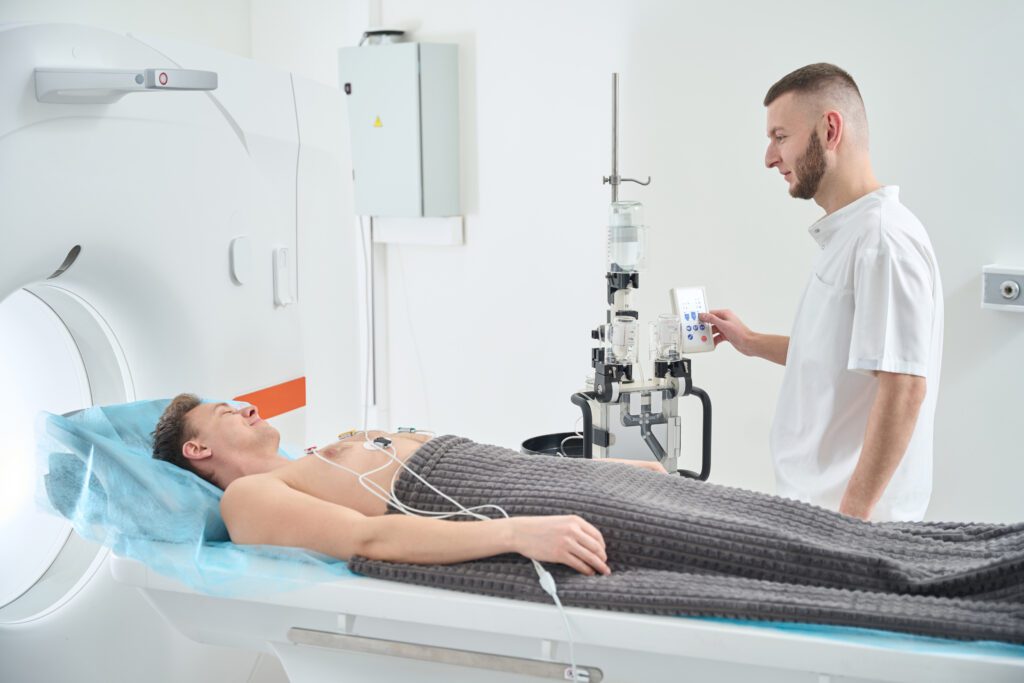If your healthcare provider suspects you may have an aneurysm, they may recommend a CT angiogram. This is a kind of CT scan that can offer detailed views of your blood vessels, helping to locate and assess potential aneurysms. While an aneurysm can exist for a long time without any symptoms, if it were to rupture or burst, it could be life-threatening.
A CT angiogram is one of the most advanced tools for diagnosing vascular conditions, including aneurysms. In this blog, we’ll explore its purpose, why your provider ordered a CT angiogram, how it works, and what to expect during the appointment.
What is a CT Angiogram, and Why is it Important?
A CT angiogram combines computed tomography (CT) imaging with a contrast dye that shows detailed images of your blood vessels and organs. This may include imaging of your brain and heart, your abdomen, and extremities like your hands and feet.
This test is critical for detecting, diagnosing, and planning treatment for diseases of blood vessels and related conditions such as:
- Aneurysms: Abnormal bulges in blood vessel walls.
- Blockages: Caused by clots or plaque buildup.
- Vascular abnormalities: Structural issues in blood vessels.
What is an aneurysm?
An aneurysm is a weakened area in the wall of a blood vessel that causes it to stretch or balloon out in size. If left untreated, it may rupture, leading to severe complications.
Why is a CT angiogram needed to diagnose an aneurysm?
A CT angiogram is an ideal tool to diagnose an aneurysm because it provides detailed images of blood vessels using contrast dye, allowing your healthcare provider to see the exact size and location of an aneurysm.
How is a CT angiogram different from a regular CT scan?
A CT angiogram is a type of CT scan that uses a contrast dye to produce more detailed images of blood vessels and tissues specifically, while a regular CT scan produces cross-sectional images of the body.
How Does a CT Angiogram Work?
A CT angiogram involves:
- Contrast Dye Injection: A contrast agent, usually iodine-based, is injected into a vein to make blood vessels appear brighter on the scan.
- Advanced Imaging: The CT scanner takes multiple images from different angles, creating a detailed, 3D visualization of your blood vessels.
This process allows healthcare providers to detect abnormalities, including aneurysms, blockages, or other vascular conditions, with unparalleled accuracy.
Why do CT angiograms require the use of contrast dye? What is contrast dye?
A CT angiogram requires contrast dye because it enhances the appearance of blood vessels on the scan. Contrast dye makes the vessels appear brighter and therefore it is easier to identify abnormalities such as aneurysms or blockages within the vessels, which would be harder to find without the dye.
Patients with iodine sensitivities should inform their healthcare provider beforehand to explore alternative options.
How does a CT angiogram diagnose an aneurysm?
A CT angiogram helps diagnose an aneurysm by creating detailed images of blood vessels using a CT scan combined with a contrast dye injection. Abnormal ballooning or weak spots in the vessel walls that could indicate an aneurysm will be highlighted by the contrast dye, making them appear brighter.
On your CT results, your blood vessels appear in 3D, which gives a more complete picture of any aneurysm that may be present. This lets your doctor see the size and location of aneurysms, so you can get the best available treatment for your condition.
How does a CT angiogram visualize the blood vessels in my body?
A CT angiogram visualizes blood vessels in your body by taking multiple images from different angles, providing 3D imagery of your blood vessels. The contrast dye helps show any blood vessel abnormalities (like an aneurysm), blockages, and the condition of your blood vessels.
What can a CT angiogram reveal about an aneurysm?
A CT angiogram provides a detailed look at blood vessel structures, so the size, shape, and location of the aneurysm are made clear. This is important because location and size help determine the risk of rupture and potential damage, which in turn can shape treatment plans. It also shows blood flow patterns around the aneurysm, which may be affecting your circulation.
Why is blood vessel wall visibility important during an aneurysm diagnosis?
The condition of your blood vessel walls is critical for understanding and treating an aneurysm. The integrity of the blood vessel walls is threatened by thinning or weakness in the wall, as well as by plaques that may have been accumulating in the blood vessels.
If the aneurysm is causing tears in the wall, that increases the risk of rupture, as does blood that may be leaking from the blood vessel wall. A clear view of vessel walls provides a more thorough assessment of the placement and size of the aneurysm.
The condition of your blood vessel walls will help determine the plan of care for treating an aneurysm.

Why is a CT angiogram so important?
The detailed 3D images recorded by a CT angiogram reveal the details of your vascular structure with precision and clarity. This includes the presence and scope of an aneurysm, plaque, narrowing of vessels, blockages, or other abnormalities.
The information obtained by the scan is valuable for both an accurate diagnosis and appropriate treatment. Doctors order this scan because it is quick, noninvasive, and painless.
Why does a CT angiogram provide more detailed information than other scans?
A CT angiogram provides more detailed information than other scans due to a combination of imaging technology and use of contrast dye. The CT scan works at a rapid speed, creating highly detailed, 3D images of the inside of your blood vessels, so your healthcare provider can reach a more certain and complete diagnosis.
The iodine-based contrast dye highlights the inside of blood vessels, allowing for clear visual evidence of blockages, aneurysms, narrowing of the vessels, or other abnormalities. Other scans are unable to provide the level of detail within blood vessels and surrounding structures that a CT angiogram provides.
How does a CT angiogram help determine the size and location of an aneurysm?
The size and location of an aneurysm are determined by the high-resolution multi-plane, 3D images of the interior of blood vessels. The vessels are highlighted by the contrast dye, which shows the aneurysm as distinct from other tissues.
The CT angiogram also shows the blood vessels in relation to adjacent tissues and organs, so a more thorough evaluation of the aneurysm, and the significance of its location, can be made.
The CT technology measures the aneurysm, including the diameter and volume, to best diagnose the condition and to determine the potential treatment options.
How can a CT angiogram help in guiding treatment decisions?
Factors influencing treatment decisions include risk assessment determined by the location, shape, and size of the aneurysm, its impact on surrounding structures or organs, and the condition of blood vessel walls. Subsequent CT angiograms can help your doctor monitor the continued health of the affected blood vessel.
What to Expect Before, During, and After an Appointment for a CT Angiogram with Touchstone Medical Imaging
Your healthcare provider will give you instructions specific to your scan, but for most people, preparing for a CT scan is easy and the recovery time is quick. Your provider will review your medical history and current health status before the scan to minimize the possibility of a reaction to the contrast dye.
A regular CT scan does not require the use of contrast dye, although it may be used in certain circumstances. Contrast usually contains iodine, so if you have known sensitivities to iodine or other contrast materials, be sure to inform your healthcare provider before the scan.
How should I prepare for a CT angiogram?
Your healthcare provider will have preparation instructions that are specific to your needs, so be sure to follow what your provider says. They may ask you to avoid eating and drinking for three to four hours before a CT angiogram.
If you have reduced kidney function, be sure to discuss this with your provider, as the contrast agent may affect the kidneys. If you may be pregnant, be sure to notify your provider as well, as some radiation is involved in the scan.
Remove any metal objects like piercings, jewelry, and glasses, as they may interfere with the accuracy of your CT results.
What happens during a CT angiogram?
The contrast dye will likely be administered through an IV in your arm or hand. Afterward, you may feel flushed or nauseous and may have a metallic taste in your mouth. These are typically minor side effects of the contrast dye and they will pass.
You will lie down on a bed-like table that slowly slides into a donut-shaped scanner. The technologist may ask you to hold your breath for a moment or two through the scan, or to hold still, to better enable the scan to take clear images. You will be able to speak with the technologist at any point during your CT scan.
The scanner may make clicking sounds while it takes the images, but that’s completely normal. The scanning process takes approximately 30 minutes to an hour.
What should I expect from my CT angiogram results?
After your scan, a radiologist will review your results and create a report detailing the findings of the CT angiogram. It typically takes about one week to get your results. This report will be shared with your healthcare provider, who will discuss the results with you, to make sure you understand everything.
Your CT angiogram results will supply the information needed for any further assessments or interventions from your healthcare provider and will help them to determine a plan for your care, so you have the best possible outcomes.
How to schedule your CT Angiogram appointment with Touchstone Medical Imaging.
Touchstone Medical Imaging offers CT imaging services in Arkansas, Colorado, Florida, Montana, Oklahoma, and Texas.
Reach out to us at Touchstone, and we’ll help you schedule an appointment at an imaging center near you, today.
We’re here to help you get the answers you need.

Frequently Asked Questions (FAQ)
A: A CT angiogram provides detailed images of blood vessels to help diagnose conditions like aneurysms and identify their location and size.
A: Yes, CT angiograms are generally safe. However, patients with kidney issues, iodine allergies, or pregnancy should discuss potential risks with their provider.
A: An aneurysm is an abnormal bulging in a blood vessel, and a CT angiogram is crucial for visualizing them, to show the potential risks to your health.
A: Unlike a standard CT scan, a CT angiogram specifically focuses on blood vessels, providing more detailed images to assess vascular conditions.
Toggle Content
A: Contrast dye helps highlight blood vessels during the scan, making it easier for doctors to see and assess potential issues like aneurysms.
A: A CT angiogram uses advanced imaging technology and contrast dye to produce clear, three-dimensional images of your blood vessels, revealing even the smallest abnormalities.
A: It can show the size, shape, and exact location of the aneurysm, as well as any potential risks to nearby blood vessels.
A: Clear images of the blood vessel walls are crucial for assessing the aneurysm’s size, whether it’s expanding, and if it’s at risk of rupturing.
A: Before the scan, you’ll be asked to prepare by avoiding food or drink, during the scan you’ll lie still while contrast dye is injected, and after, you may be monitored for any reactions to the dye.

